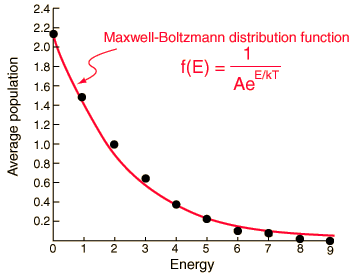This question is about my misunderstanding of the differences between and shapes of the Boltzmann and Maxwell-Boltzmann distributions.
I understand that the Boltzmann distribution arises as the solution to the constrained maximum entropy optimisation, and that it is commonly written:
$$ p_i =\frac{e^{-E_i/kT}}{\sum_{j=1}^Me^{-E_j/kT}},$$
where $j$ and $i$ index the state of some system with energy levels $E_i$ increasing in $i$. $T$ is the temperature, which was introduced as the reciprocal of a Lagrange multiplier and $k$ is Botlzmann's constant.
Now if someone were to ask me to draw the probability density function of the states for different energies, I would draw something similar to this:
In particular, the density would take its maximum value at $E=0$. When I read the wikipedia page for the Maxwell-Boltzmann distribution, they start with the distribution I have above and then proceed to find the distribution of momenta. They then transform the distribution back to a distribution of energy, but somehow the distribution now has a different shape. In particular:
$$ f(E) = 2\sqrt{\frac{E}{\pi}}\frac{1}{(kT)^{3/2}}\exp\Big(\frac{-E}{kT}\Big).$$
This expression clearly does not have the maximum value at $E=0$. Why is the new energy distribution different to the first one? Perhaps my failure to understand this is related to the condition they have: $f_E(E)\,dE=f_p(\mathbf{p})d^3\mathbf{p}.$

